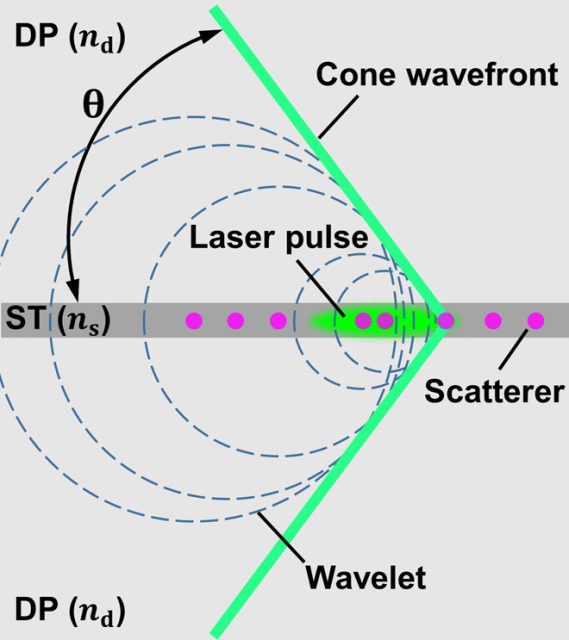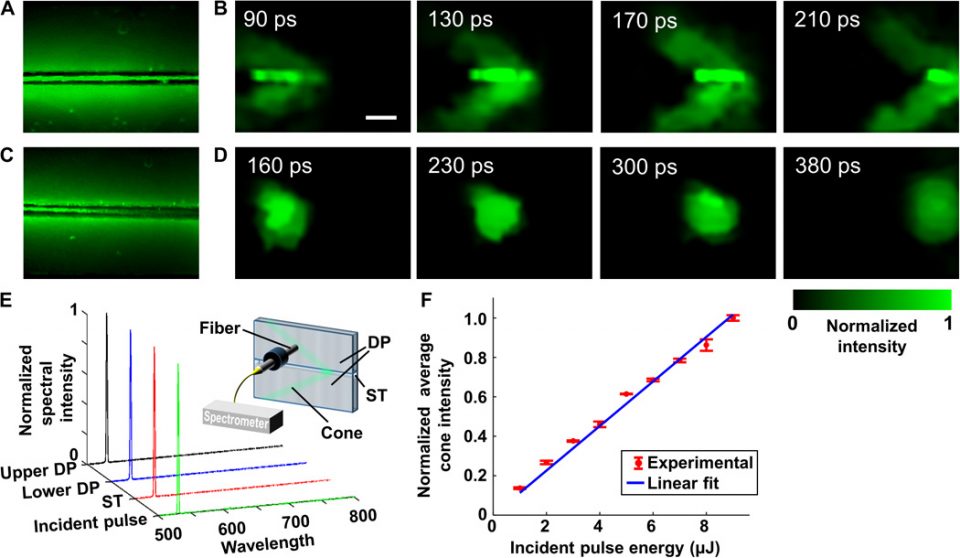Last Updated on March 1, 2021 by Editor Futurescope
An event at the speed of light, to be recorded in detail, requires an even faster camera. And a new technology has allowed to capture for the first time in video the cone of a sonic boom of a beam of light in real time. A team of researchers at the University of Washington in St. Louis did so with a specially designed camera and the findings of their study were published by Science Advances.
The boom or sonic shock as we know it is the shock wave that produces, for example, like airplanes flying at supersonic speeds that create cone-shaped sound bursts when breaking the sound barrier. When an aircraft flies at a speed higher than that of sound (an average of 343.2 m / s in Earth’s atmosphere), the sound waves produced by its trajectory collide with each other, being violently displaced by the vehicle it is Their source and traveling faster than they, and adopt at that moment a form known as the cone of Mach has captured the first video of these events.
The new technology used to make this discovery could someday allow scientists to help see the neurons and image the activity live in the brain, researchers say.
The science behind technology
When an object moves through the air, it propels the air in front of it, creating pressure waves that move at the speed of sound in all directions. If the object moves at speeds equal to or greater than the sound, it overcomes those pressure waves. As a result, the pressure waves of these accelerating objects pile up on top of one another to create shock waves known as increases or sonic explosions, which are similar to the sounds of thunder.
The light travels at a speed of about 300,000 kilometers per second as it moves through the vacuum. According to Einstein’s theory of relativity, nothing can travel faster than the speed of light in the vacuum. However, light can travel more slowly than its maximum speed – for example, light moves through the glass at speeds of approximately 60 percent of its maximum.


The lead author of this study, Jinyang Liang, an optical engineer at the University of Washington in St. Louis, and his colleagues designed a narrow tunnel filled with dry ice fog. This tunnel was sandwiched between plates made of a mixture of silicone rubber and aluminum oxide powder.
The researchers then fired pulses of green laser light – each lasting only 7 picoseconds – down the tunnel. These impulses could disperse dry ice particles into the tunnel, generating light waves that could enter the surrounding plates.


Dr. Jinyang Liang, the leader of the team, says that unlike ordinary video cameras, the one used to record the sonic boom of light and its subsequent cone of Mach “works by capturing all the images of a fused dynamic event in a single snapshot “.
“We made the first-ever video recording of a propagating light-induced photonic Mach cone in real time,” Dr. Liang told IFLScience. “This dynamic light scattering event was captured in a single camera exposure by the newly developed single-shot lossless-encoding compressed ultrafast photography (LLE-CUP) at 100 billion frames per second.”


The technique, called “lossless-encoding compressed ultrafast photography” (LLE-CUP), records 100,000 million frames per second, allowing you to create real-time video of light scattering with a single snapshot.
Though High speed video isn’t all that new. In 2011, MIT developed a camera that could capture a pulse of light making its way through a plastic bottle.
In order to register the cone of Mach de la luz, Liang and his colleagues had to employ a trick to imitate a beam of light breaking their own speed limit (and leaving behind them the cone of electromagnetic waves, like the plane traveling faster Than their own sound).
To do this, they fired a laser through a channel filled with vapors of dry ice (through cold gases, light travels even faster), coated with silicone panels, which rather delay the displacement of light. The difference in velocities with which the laser pulse shifted on both surfaces formed a cone-shaped crash wave behind the laser, as when the sonic boom seems to chase the plane.


This technology of recording of images has been used in medicine and the study of light but requiring numerous snapshots to adequately recreate the scene that is recording, this scene must be easily repeatable in the laboratory to be photographed.
This system could be used with standard cameras, microscopes and even telescopes, says Liang. Its practical utility for science lies in the detection of tiny cells like neurons or cancer cells.





